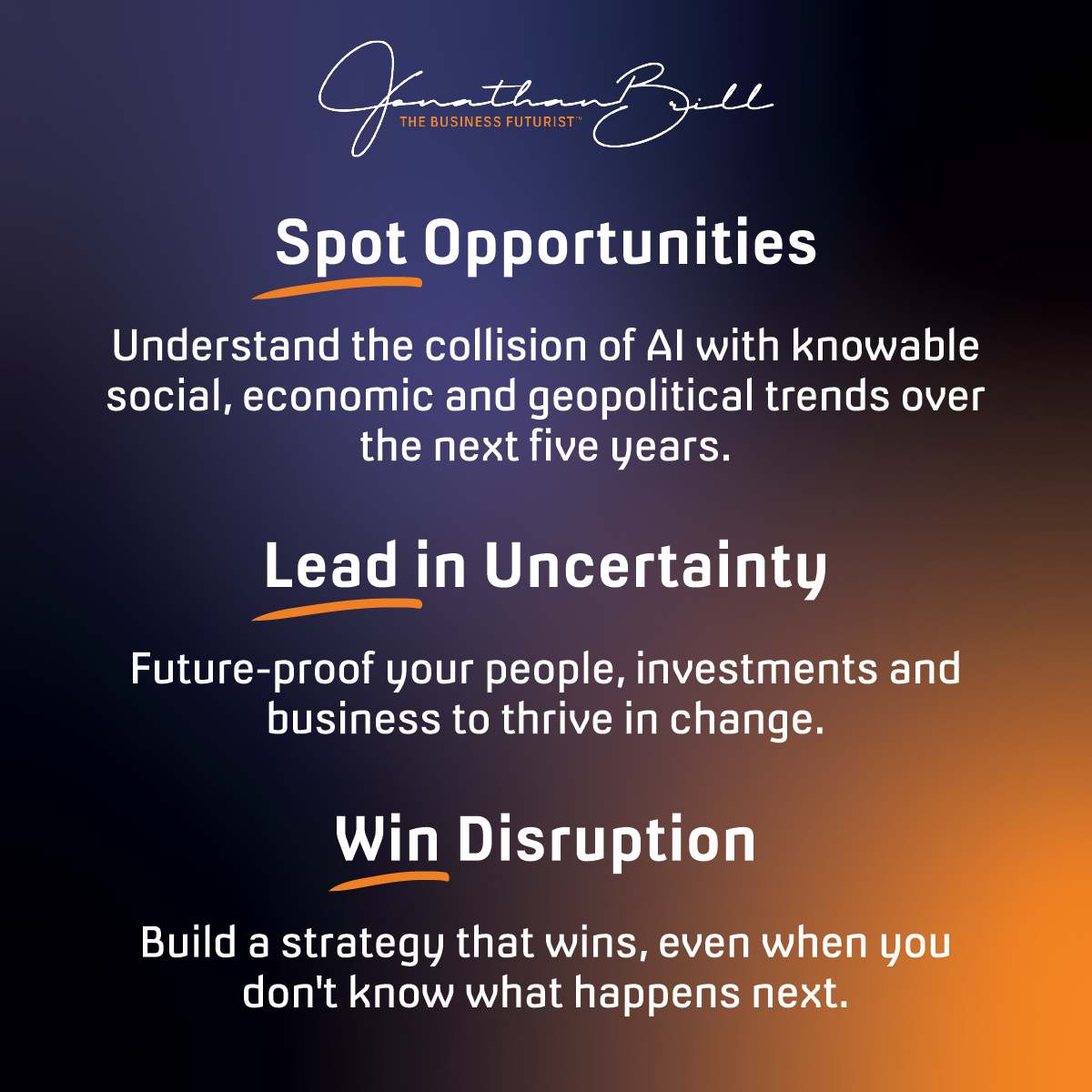Liberation Day, AI and the geopolitical implications, 2025 is shaping up to be the year of chaos. Events that even the savviest business leader would have had a hard time predicting or planning for. That’s understandable as we tend to underestimate the likelihood of things we have not experienced and overestimate the likelihood of recent experience.
Yet it’s absolutely possible to turn chaos into opportunity and make dramatically better decisions about the future if you know where to look and what actions to take.
Mastering What Happens Next
The future is often seen as a mystery, an unpredictable force that we have little control over. Alternatively, some people view it as something preordained, where their fate is already sealed, leaving them powerless. Both perspectives are misguided. If you know how to approach the future, ask the right questions, and prepare accordingly, you can turn the future into one of your greatest business advantages.
Understanding Cause and Effect
At the heart of predicting the future is a simple concept: cause and effect. The present directly drives the future, and when we understand this relationship, we unlock the power to influence what happens next. The future isn’t something that happens to us; it’s something we can actively shape. The first step is to look beyond your immediate surroundings. It means stepping outside the comfort of your office and surveying the larger landscape—taking note of what’s happening in the world.
As a manager, if you were taught to be an effective operator, you were taught to control what you can and ignore the rest. And so, your answer right now, your question should be, well, I can’t prepare for every unexpected moment.
And the answer is you don’t. What you need to do is prepare for the second domino, what happens after the disruption, because there will be consistent stressors on your business, shapes of risk on your business, independent of what those disruptions are. In 2011, after the Fukushima nuclear disaster, Toyota was shut down because there were single point vendors that were manufacturing components around Fukushima, so they stepped back. They said, “What are 250 single point risks in our organization, components in our business that we need to deal with?” And they bought stockpiles of those single source components, and they gave them to somebody else who lent against them at prime plus one. So, they were basically paying nothing for these things after taxes. When COVID hit, every other major automobile manufacturer on the planet was disrupted. Entire production lines were stopped for companies like GM because they didn’t have enough semiconductors, and electronic components such as $1 connectors for video displays in their car dashboards.
And yet, Toyota became the largest automobile manufacturer in the world because it was able to reorient its operations, stockpiling strategic inventory, and diversifying its suppliers. Toyota was able to become effective, to lean in when everyone else had to pull back.
Research from McKinsey Global Institute suggests that companies that plan for disruption, instead of avoiding it do 81% higher economic profit over a 14-year period. The thing is, you don’t get to decide when that period is, so you don’t know where in that window you are right now.
Identifying Collision Points
Every day, we’re bombarded with news headlines—most of them highlighting crises, challenges, or changes. But it’s not just the individual headlines that matter; it’s the overarching themes that begin to emerge over time. These themes can be social, economic, geopolitical, or technological, and when you examine them in the larger context, you begin to see how they’re interwoven.
The future doesn’t come from a single headline or isolated event. It happens when these forces collide. That’s where disruption occurs. That’s when rules change, and opportunity is greatest. The future is not a distant, abstract concept; it’s happening now, in the convergence of these global forces.
Three Key Questions Every Leader Should Ask
Leaders who are truly ready for the future ask themselves three crucial questions:
- Why is your future changing?
Understanding why the future is changing is at the core of strategic foresight. It’s about recognizing the trends and forces that are reshaping the world. What patterns are emerging? How are these trends interacting, and what impact might they have on your business? The more you understand the causes of change, the better you can anticipate what’s to come. - What can you do about it?
The future is not a straight path, and surprises are inevitable. There’s always a surprise around the bend, but if you look you can often see its shadow poking out. How often do you think about that corner, the potential disruptions or innovations that lie just beyond your line of sight? By staying proactive, you give yourself the flexibility to adapt and alter your course of action before circumstances dictate it for you. - How do we start?
Your future is your most valuable resource—it’s the only thing you can directly affect. So, what is the most important thing you already know, the one fact you’re aware of but haven’t yet acted upon? What decisions must you make now, this year, and in the next three years, in order to thrive for the next five? The future is shaped by the steps we take today, and it’s important to begin that journey with purpose and intention.
Disruption is the Result of Growth and Increasing Opportunity
When we see disruption in the world, it’s easy to view it as something negative, something to be feared or avoided. However, much of the disruption we’re experiencing today is not a sign of decline but a direct result of growth and expansion. Increasing human potential, economic growth, and technological advancement are leading us to a place where the rules are changing. This presents a critical opportunity: when the rules change, so too do the possibilities.
In recent years Amazon has been doubling down on their healthcare initiatives. Already seeing the potential for online pharmacies that could leverage their existing supply-chain infrastructure they noticed additional opportunities in the post-Covid rise of telehealth, and AI’s potential to automate administrative healthcare tasks. These collision points have become the cornerstone to their multi-faced approach to healthcare disruption and future dominance.
Ask yourself: will you continue to play by the old rules? Or will you invent new ones that allow you to seize these opportunities? The key is to recognize that disruption is not a force to be feared, but one to be harnessed. By understanding how disruption arises from growth and opportunity, you can position yourself—and your organization—at the forefront of these changes.
Disruption is the Result of Growth and Increasing Opportunity
When we see disruption in the world, it’s easy to view it as something negative, something to be feared or avoided. However, much of the disruption we’re experiencing today is not a sign of decline but a direct result of growth and expansion. Increasing human potential, economic growth, and technological advancement are leading us to a place where the rules are changing. This presents a critical opportunity: when the rules change, so too do the possibilities.
In recent years Amazon has been doubling down on their healthcare initiatives. Already seeing the potential for online pharmacies that could leverage their existing supply-chain infrastructure they noticed additional opportunities in the post-Covid rise of telehealth, and AI’s potential to automate administrative healthcare tasks. These collision points have become the cornerstone to their multi-faced approach to healthcare disruption and future dominance.
Ask yourself: will you continue to play by the old rules? Or will you invent new ones that allow you to seize these opportunities? The key is to recognize that disruption is not a force to be feared, but one to be harnessed. By understanding how disruption arises from growth and opportunity, you can position yourself—and your organization—at the forefront of these changes.
Leaning Into a New Way of Thinking
In order to shape the future, we need to adopt a new mindset. This is not just about being reactive or waiting for the future to unfold. It’s about leaning into new ways of thinking, working, and planning. The choices we make today directly influence the options available to us tomorrow. When we recognize the cause-and-effect relationship between present actions and future outcomes, we can make decisions that position us to capitalize on the opportunities ahead.
Our industry and our investors often require that we plan for the near future—this year, or maybe even the next two or three years. But what happens when you get there? Are you ready for what happens next? Knowing the options you must create, and when, lets you make better choices when the time arises with the facts you have. Even when you don’t have time to deliberate, you can still be deliberate. Preparing for the future requires thinking beyond immediate needs and considering the longer horizon. It’s about being proactive and strategic, understanding that your future is shaped by the decisions you make today.

Shaping the Future with Deliberate Decisions
Knowing what options you need to create, and when to create them, gives you the power to make better decisions when the time comes. Even in situations where you don’t have the luxury of time to deliberate, you can still be deliberate in your choices. Being prepared means that when the moment arrives, you can make decisions with confidence and clarity, knowing you’ve already considered the long-term implications.
Over the next five years, we can expect to see major geo-political shifts. Trump’s saber rattling is a side show. We’re going to see India and China increasingly doing trade together. We’re going to see India buying more energy from Russia to support its population. We will see as much as a 150% increase in global defense spending.
We’re seeing a reorientation of the world, and it will redefine the trade lines, the frontiers, and the technologies of the world. How will this impact your business and investments. Are there financial and operational risks for your organization? Where are the external and strategic risks for your organization? Are these investments increasing your ability to move, to lean in when the world changes or are they increasing your ability to operate, assuming that it stays the same.
The Impact of AI on Your Business
When you look at AI and the disruptive transformation it promises, have you truly considered the broad impact AI will have on your business? It’s not just about automating individual tasks; AI will have profound effects on the output level, on the people within your organization, and on the organizational structure itself.
As a leader, you should be asking yourself: how will you harness AI to make better decisions? How will you use it to democratize critical decision making, so it can happen at all levels of your organization, and how will that change the nature of work and reshape your organization? What can you start doing today to bring strategy down deeper into your firms, and at the same time, you help you bring agility up from the bottom to the top.
The decisions you make now will determine how well you can adapt to the changes AI will bring in the next five years.
The Greatest Opportunity in Human History
We are living in a time of unparalleled opportunity. The technological, social, and economic changes happening today are the most significant in human history. However, too many people are looking at these opportunities in the wrong way.
We can either sit back and hope we aren’t negatively affected by these changes, or we can lean in and become active participants in shaping the future.
The choice is yours. Will you wait for the future to unfold around you, or will you lean forward, embrace the challenges, and turn them into your greatest opportunities? This is the moment for business leaders to decide: will you react to the future, or will you shape it?



